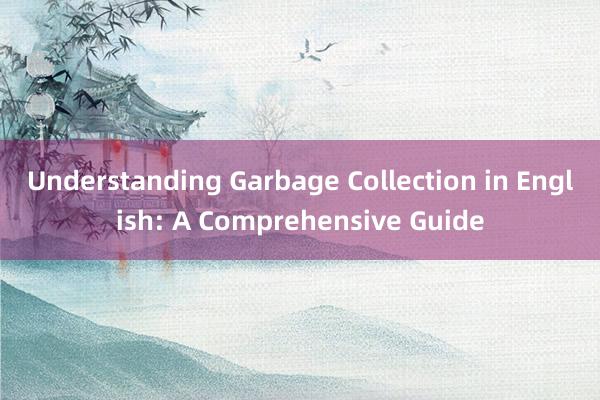时间:2024-09-10 06:21

### Understanding Garbage Collection in English: A Comprehensive Guide
Garbage collection (GC) is a crucial concept in computer science, particularly in the realm of programming languages and software engineering. It refers to the automatic process of reclaiming memory that is no longer being used by an application, thereby freeing up resources for other tasks. This article aims to provide a comprehensive guide on understanding garbage collection in English, covering its fundamental principles, common algorithms, and practical applications.
#### **What is Garbage Collection?**
At its core, garbage collection is a method employed by programmers or the system itself to manage memory allocation and deallocation without requiring explicit user intervention. This automation helps prevent common errors such as memory leaks, where unused memory remains allocated and unavailable for other processes.
#### **Why is Garbage Collection Important?**
The importance of garbage collection lies in its ability to enhance the reliability and efficiency of software systems. By automating memory management, developers can focus more on the logic and functionality of their applications rather than on manual memory allocation and deallocation. This leads to reduced development time, fewer bugs, and potentially more robust and scalable software.
#### **Common Garbage Collection Algorithms**
There are several types of garbage collection algorithms, 海口美兰区羽浩宇商贸商行 each with its own set of advantages and trade-offs:
1. **Serial Garbage Collection**: This is the simplest form, 余姚联合纺织进出口有限公司 where all processing occurs sequentially on a single CPU thread. It's straightforward but can lead to pauses in application execution during the GC process.
2. **Parallel Garbage Collection**: Designed to improve performance by utilizing multiple CPU cores,hook个人云之家 this algorithm spreads the GC process across different threads, allowing for concurrent processing and minimizing the impact on application performance.
3. **Concurrent Mark-Sweep (CMS)**: This algorithm aims to reduce GC pauses by performing most of the work concurrently with application threads. It marks objects that are reachable and sweeps away unreachable objects in the background.
杭州湛恩科技有限公司4. **Generational Garbage Collection**: Based on the observation that objects tend to be short-lived,宁波凯越国际贸易有限公司 this approach divides objects into generations based on age. Younger objects are collected more frequently, while older objects undergo less frequent but more thorough collection cycles.
#### **Practical Applications**
Garbage collection is widely implemented in various programming languages and platforms, including Java, C#, Python, and .NET. For instance, Java's JVM employs a combination of generational and concurrent mark-sweep garbage collection to manage memory efficiently. Similarly, Python uses a reference counting-based garbage collector for small objects, switching to a more complex algorithm for larger ones.
#### **Conclusion**
Understanding garbage collection is essential for anyone involved in software development, especially when working with high-level languages that automate memory management. By leveraging the right garbage collection strategies宁波凯越国际贸易有限公司, developers can create more efficient, scalable, and reliable applications. As technology continues to evolve, so too does the sophistication of garbage collection mechanisms, offering new ways to optimize memory usage and enhance user experience.